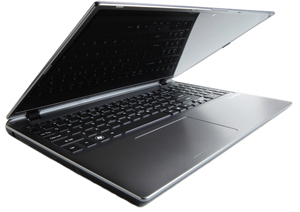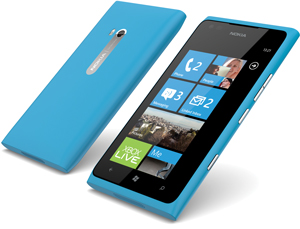In-Depth
Windows Hardware Gallery: Thinner, Lighter, Faster
When it comes to tech hardware, the trend is unquestionably mobility. In this special feature, we survey the latest in Windows-based mobile hardware -- from ultrabooks to smartphones to tablets.
- By Gladys Rama
- May 16, 2012
Click on the links below to jump to a category:
Ultrabooks
Microsoft hardware manufacturers are starting to make inroads into the thin, light and stylish category of ultrabooks that Apple Inc. has carved out with the MacBook Air. The growing crop of Windows-based ultrabooks emphasizes portability and functionality.
HP Folio 13 Ultrabook
Hewlett-Packard Co. touts the Folio 13 as its first ultrabook. It boasts a 13.3-inch screen and almost 10 hours of battery life. The Folio 13 weighs in at 3.3 pounds and is less than three-quarters of an inch thick -- when open, the base is thinner than the diameter of a dime. With a starting list price of $899.99, it's priced well below a comparably sized MacBook Air.
Acer Aspire Timeline Ultra M3
Acer Inc. calls the Aspire Timeline Ultra M3 the "industry's first 15-inch, two-spindle ultrabook" with an optical drive for DVDs. One big selling point, Acer says, is the product's speed: It can recover from Sleep mode in 1.5 seconds, and can connect to the Internet in 2.5 seconds. The Aspire Timeline Ultra M3 promises eight hours of battery life and has a sizable 15-inch screen; it weighs 4.4 pounds and is 0.79 inches thick. Acer hasn't yet announced the pricing for Aspire Timeline Ultra M3, but other ultrabooks in the Timeline family range from $629 to $779.99.
 |
HP Envy 14 Spectre
The body of the HP Envy 14 Spectre is covered in scratch-resistant glass, making it the first scratch-proof ultrabook, according to the company. It comes in at just under 4 pounds, promises 9.5 hours of battery life and is 0.79 inches thick. The 14-inch display is backlit with a built-in HD webcam, and the ultrabook comes preloaded with full versions of Adobe Photoshop Elements and Premiere Elements. Pricing starts at $1,399.99.
Back to top
Smartphones
Microsoft is making a focused effort to increase Windows Phone advertising to consumers, particularly those in the market for low-end smartphones. At the recent Mobile World Congress event in Barcelona, Spain, Microsoft announced that it was lowering its hardware requirements for Windows Phone to accommodate low-end devices and buyers in developing markets.
Nokia Lumia 900
The Nokia Lumia 900, which was released in early April, has been generating buzz since it was first unveiled at January's Consumer Electronics Show. Starting at $99.99, the Lumia 900 is part of Microsoft's push into the low-end smartphone market, and the aggressive pricing already seems to be paying off; just days after its release, Amazon.com Inc. reported the Lumia 900 reached No. 1 on its mobile device sales chart. The device supports 4G/LTE and has a 4.3-inch touchscreen, an 8-megapixel camera and -- unlike previous Lumias -- also features a front-facing, 1-megapixel camera.
 |
HTC Titan II
The Titan II is the first phone from HTC Corp. to support 4G/LTE. It was released at the same time as the Nokia Lumia 900, but priced higher at $199.99. However, it features a 16-megapixel camera -- that's twice the megapixels in the original Titan device. Indeed, HTC seems to be positioning the Titan II as one alternative to regular digital cameras. It also comes with a 1.3-megapixel front-facing camera and has a 4.7-inch display.
Nokia Lumia 610
Nokia unveiled the Lumia 610 during the Mobile World Congress. Like the Lumia 900, the Lumia 610 is being marketed on the strength of its affordability; at 189 euros (the phone is not yet available in the United States), the Lumia 610 is the most affordable device in the Nokia Lumia line. It features a relatively small 3.7-inch display and a 5-megapixel camera (but no front-facing camera, unlike the other smartphones included here). A version enabled for Near Field Communication (NFC) is expected in Q3 of 2012.
Back to top
Tablets
Microsoft is positioning Windows 8 -- which is expected to be released by year's end -- as a tablet-focused OS. Regardless of Windows 8, Microsoft will likely still be chasing the Apple iPad in the tablet market share rankings for some time to come. Much of the latest crop of Windows-based tablets share more than a passing likeness to the flagship Apple tablet device.
Samsung Series 7 Slate
The Series 7 slate, released last fall, is similar to the Samsung tablet preloaded with Windows 8 that Microsoft gave away to 5,000 BUILD conference attendees. Weighing just shy of 2 pounds, it features a 3-megapixel camera, a 2-megapixel front-facing camera and an 11.6-inch touchscreen -- almost a full 2 inches larger than the display on the latest Apple iPad. However, it's also considerably more expensive than the iPad; the Series 7 Slate ranges from $1,099 to $1,349.
HP Slate 2 Tablet PC
HP is aiming the Slate 2 Tablet PC at businesses and organizations in the health care, education, retail and government industries. The 8.9-inch display responds to touch as well as stylus devices (via the "swype"-enabled keyboard). It also features a 3-megapixel camera and starts at 1.5 pounds. The Slate 2 Tablet PC costs either $699 or $799, depending on the model.
Lenovo IdeaPad Yoga
Like its name suggests, the IdeaPad Yoga "bends" the tablet category by being a convertible device. Its hinged design allows the device to be used in four configurations: tablet, ultrabook, stand and tent (for viewing videos hands-free). Additionally, it features a 13.1-inch screen, weighs 3.1 pounds and is 0.67 inches thin -- making it the thinnest convertible ultrabook, according to Lenovo. The IdeaPad Yoga will debut sometime in the second half of 2012 running on Windows 8, and will start at $1,199.
Back to top
See Also: